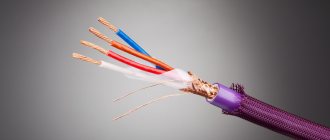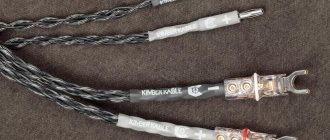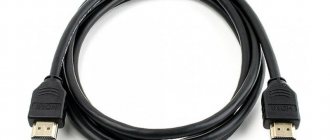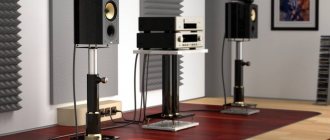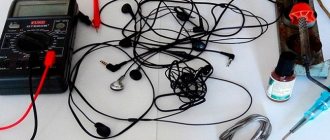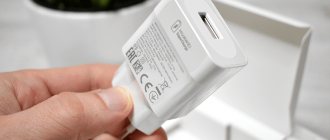Wiring may vary from manufacturer to manufacturer!
Example of mini-XLR wiring - Shure WL183, WL184, WL185 lavaliers:
Wiring out Speakon connectors
- not in the tables. It would probably be more correct to write “pinout”, since the Speakon cable connectors themselves are not made for cable soldering, the contacts are only on screws. Block connectors can be soldered. In nature, there are 2, 4 and 8-pin Speakon connectors. Starting from 4-pin, they are marked in groups - group No. 1 - “1+” and “1-”, group No. 2 - “2+” and “2-”, etc. Usually, “by default”, they are used pins +1 and -1 of the Speakon connector.
DMX-512 cable wiring.
Cables (connectors) for signal transmission via the DMX-512 protocol are three- and five-pin. The wiring is absolutely identical to the wiring of the microphone cable, that is, 1 -> 1, 2 -> 2, 3 -> 3 (4 -> 4, 5 -> 5). Only there is a small peculiarity that the “hot” or main contact in DMX-512 is No. 3, and not No. 2, as in audio equipment. Therefore, sometimes a wire with red insulation is soldered to pin No. 3, rather than white. There may be confusion. If 2 signal contacts or all three break at once, it is strongly recommended to look at the wiring at the other end of the cable and do the same at the non-working end. If you swap contacts No. 2 and No. 3, the devices will “mirror” at best, and in the worst case they may not work at all. Everyone also recommends installing a so-called terminator at the end of the DMX-512 chain - a 3 or 5 pin XLR connector with a resistance of 90-120 Ohms soldered inside between pins No. 2 and No. 3. Especially if there are a lot of devices and the line is long. In general, the DMX-512 protocol allows lines up to 500 meters long. Wiring details:
Date added: 2015-08-31 ; . Copyright infringement
Wiring may vary from manufacturer to manufacturer!
Example of mini-XLR wiring - Shure WL183, WL184, WL185 lavaliers:
Wiring out Speakon connectors
- not in the tables. It would probably be more correct to write “pinout”, since the Speakon cable connectors themselves are not made for cable soldering, the contacts are only on screws. Block connectors can be soldered. In nature, there are 2, 4 and 8-pin Speakon connectors. Starting from 4-pin, they are marked in groups - group No. 1 - “1+” and “1-”, group No. 2 - “2+” and “2-”, etc. Usually, “by default”, they are used pins +1 and -1 of the Speakon connector.
DMX-512 cable wiring.
Cables (connectors) for signal transmission via the DMX-512 protocol are three- and five-pin. The wiring is absolutely identical to the wiring of the microphone cable, that is, 1 -> 1, 2 -> 2, 3 -> 3 (4 -> 4, 5 -> 5). Only there is a small peculiarity that the “hot” or main contact in DMX-512 is No. 3, and not No. 2, as in audio equipment. Therefore, sometimes a wire with red insulation is soldered to pin No. 3, rather than white. There may be confusion. If 2 signal contacts or all three break at once, it is strongly recommended to look at the wiring at the other end of the cable and do the same at the non-working end. If you swap contacts No. 2 and No. 3, the devices will “mirror” at best, and in the worst case they may not work at all. Everyone also recommends installing a so-called terminator at the end of the DMX-512 chain - a 3 or 5 pin XLR connector with a resistance of 90-120 Ohms soldered inside between pins No. 2 and No. 3. Especially if there are a lot of devices and the line is long. In general, the DMX-512 protocol allows lines up to 500 meters long. Wiring details:
Date added: 2015-08-31 ; . Copyright infringement
Before moving on to the question of what an XLR connector is , we need to touch on the understanding of the causes of interference and the classification of audio signal transmission. Since the advent of electricity, a person’s daily life, his daily life and entertainment has changed dramatically. Devices have appeared without which modern man can no longer live a day. These are all kinds of lighting devices, electric motors involved in production and in everyday life, their use entails an increase in living standards. It seems impossible to remain without them now, however, electricity as a form of energy is considered a pollutant and a source of interference for any audio signal transmitted over a distance. Household appliances, the Internet, stabilizers, refrigerators, mixers, rectifiers, etc. cause extraneous noise in the audio channel. Thus, there is a need for protection from external negative influences transmitted through cords and connectors, sound signals of different frequencies and amplitudes.
Causes of Interference
The generation of the sound signal and its processing into an electrical impulse begins from the microphone and is transmitted to the first pre-amplification stage. It is in this area that the audio signal is most susceptible to the influence of various sources of interference. If you do not protect it during the first transportation via cable, then even the slightest clicks will be heard on the final amplifier, from breaking the contact in the light switch to the operation of the refrigerator compressor. Thus, any signal entering the amplifier’s external connector will be amplified along with the original coming from the microphone. The interference, amplified tens of times, will drown out the voice and the sound will be disgusting. To do this, you need to seek help only from stores and sellers who specialize in means of playing and transmitting audio signals. Because money spent on low-quality goods will quickly disappoint its owner.
Pinout diagrams by manufacturer
Apple audio pinout
- 1 - left
- 2 - right
- 3 - ground
- 4 - microphone
iPod Nano (4th, 5th Gen), iPhone (1st, 2nd, 3rd, 4th Gen), iPod Shuffle (3rd Gen), Cell Phone Connection iPhone headphone (handsfree)
Lenovo audio pinouts
1 - left 2 - right 3 - ground 4 - microphone
Lenovo Thinkpad Edge & X Series Notebook audio
Samsung audio pinouts
1 - left 2 - right 3 - ground 4 - microphone
Samsung Galaxy S I9000, S8500 Wave headset EHS60AVNBE / EHS60ANNWEGSTA / EHS60ANNBECSTD/ GH59-09752A headset Samsung Galaxy S2 i9100 headset should be compatible with Samsung Galaxy Note N7000, Samsung Galaxy Tab GT-P1000, P7100 Galaxy Tab 10.1, 4G LTE, C3530 , [ email protected] 350, Galaxy 551 i5510, Galaxy 550 I5500, E2330, I100 Gem, i220 Code, i350 Intrepid, I9003 Galaxy SL, I9100 Galaxy S II, i997 Infuse 4G, Google/Samsung Nexus S I9023/I9020, [email protected ] 335 S3350, Galaxy mini S5570, Wave 525 S5250, Star II S5260, Wave II S8530, S5780 Wave 578, Wave 533 S5330, Galaxy Gio S5660, Wave 723 S7230, Galaxy Ace S5830, Galaxy Fit S5670, Galaxy S 4G, Galaxy S WiFi 5.0 , R910 Galaxy Indulge, S3850 Corby II, M190 Galaxy S Hoppin, M210S Wave2, M220L Galaxy Neo, M580 Replenish, C6712 Star II DUOS
Samsung i300, i330, i500, i700 handsfree/headset connector
Samsung OEM EHS64 Headset for Samsung Galaxy SIII GT-i9305 and some others
Samsung Series 9 Notebook headset (NP900X3D-A02DE)
Samsung SPH-a420, a580, a640, m220, m240, m300, m320, m330, Rant m540, Exclaim m550 SCH-R451C headset Samsung headset P/N: AEP010SLEB/STD
Samsung SPH-A880, SCH-U620, SCH-U540, SPH-M500, SCH-A950, SCH-A870, SCH-A930, SPH-A920, SPH-A940, SCH-A970, SPH-A900 BLADE, A900M, SCH- A990, SCH-U740 AEP204VBEB/STD Headset/Music
In some Samsung models, the ground contact and microphone can be swapped!
What is a microphone cable made of?
To protect the weak low-voltage sound signal generated in the microphone, it must be transmitted via a special cable and connected only through an XLR connector . All this together makes it possible to transmit a clear audio signal without distortion.
A microphone cable consists of three main components:
- Copper conductors - conductors through which sound transformed into an electrical impulse will pass. Copper in this case is the optimal conductor both in terms of current conductivity and price, and in terms of resistance and ductility. Another advantage of copper used for cables of this type is the possibility of its easy soldering, as the only way to connect the core and connector elements. It must be remembered that the lower its resistance and length, the less loss there will be of a weak pulse going from the microphone to the receiving device, this can be a mixer or pre-amplifier. The conductors have a multi-core design, since it is this that is less prone to fractures during bending.
- Screen. Protection against interference and signal passage through the wires without external distortion directly depends on its density and quality of the braid. The screen can be made of tinned or untinned copper.
- Insulation of each core. It is made of a plastic material that has dielectric properties so that the copper conductors do not touch each other and do not influence electrically. Most often this is PVC insulation as it is highly resistant to bending, temperature and has excellent insulating properties.
Three-pin XLR type connector . This standard connector is used to connect microphones . Two contact elements carry audio information, and the third is connected to the housing, which is grounded when optimally installed.
The more expensive the better?
Since balanced cables are usually used to connect microphones, the logical question is: how much does a good balanced microphone cable cost? Is it worth overpaying and how to assess the feasibility of such a purchase?
This is exactly the case when there are so many people, so many opinions. But there are some universal tips regarding the cost of cable.
- Avoid the cheapest Chinese noname cables. No one is responsible for their quality; they may not work at all or stop working in a week. Take pity on your nerves. Also, under the guise of balanced cables, they can sell you unbalanced ones. The very low price should definitely alert you.
- The most expensive cables are worth buying if you simply have nowhere to spend the money or if you want to purchase a collector's item. They look impressive and expensive, but often the technologies used in their manufacture provide capacitance and inductance that are not reflected in the best way on the frequency response of the transmitted sound. At best, you will either not feel the difference in sound, or you will understand that it is not worth as many zeros as they are asking for it.
- Mid-price cable - excellent price/quality ratio.
The price and quality of the cable are influenced by the following factors:
- Number of cores
: the more of them, the more flexible the cable and, as a result, such a cable will last longer.
- Twisting the wire
. The main indicator is the twist length. This is the distance between the nearest turns of wire. The more turns per unit length, the shorter the twist length, the more expensive the cable. The fact is that reducing the twist length increases the flexibility of the wire and noise reduction.
- Shielding
. Shielding was written above; we only note that more expensive cables use braiding.
- Shock absorption
, which is important when using a cable on stage, when when it falls, a triboelectric effect occurs and an impact sound is heard. To absorb shocks in expensive cables, special external insulation materials are used.
- Connector conductivity
. You've probably heard about gold-plated connectors. To increase electrical conductivity, some manufacturers coat the contact area with various metals, usually gold or silver. And although the latter is cheaper and conducts electricity better, it oxidizes quickly and often has to be cleaned, so the choice falls in favor of the more expensive gold.
- Star twisting is a technology in which not two cores are twisted, but four (two “+” and two “-”). This technology can significantly reduce electromagnetic interference by reducing the loop area. Star-twisted cable provides better sound by changing phase shift and reducing crosstalk.
Types of XLR connectors
First, let's look at what a standard XLR connector is and why it has such a name.
The abbreviation stands for as follows:
- The first letter "X" is a series of connectors founded by Cannon Electric in California, or more precisely in Los Angeles, by James Canon. By the way, among professionals in the colloquial lexicon the connector itself is sometimes called Canon.
- The second letter “L” means that it is equipped with a snap-on connecting mechanism; it is thanks to this fixation that this connector is successfully used not only when installing devices and equipment on panels, but also when connecting two separate pieces of cable.
- The third letter “R” is a designation of the material that insulates the contacts inside the connector. Since plastic insulating materials had problems with oxidation of copper contact pins, the developers decided to replace them with rubberized ones, which at the same time, when connecting two elements of a detachable connection, skillfully clean them of this harmful deposit. However, if gold-plated or tin-plated contact pins are used, then a solid plastic insulator is no less effective. That is, if the letter “P” is indicated at the end, this means that plastic is used as the main type of insulator.
Sometimes you can find an XLR connector that has from three to five pins, but still it is the three-pin ones that have the largest area of application and are common among lovers of high-quality music.
Audio cables and adapters: types and purpose.
Currently, there are many audio transmission standards. They were developed by different companies at different times and it is not surprising that different standards use different connectors and cables. If this does not cause problems within one device, then when expanding a multimedia system, sooner or later you will encounter problems when transmitting an audio signal from one device to another. These problems can be divided into three types:
1. There is no standard cable or its length is not enough.
2. Paired devices use the same audio signal transmission standard, but have different connectors.
3. The paired devices use different audio standards.
The first problem can be solved using audio cables. You can lengthen the standard connection cable using an extension cable, or (preferably) replace it with a longer connection cable. Sometimes it becomes necessary to assemble the cable yourself - then, in addition to the speaker cable, you will need to purchase connectors.
To solve the second problem, adapters are designed, which are a pair of connectors of different standards connected in a small housing. Here you need to have a good understanding of which connectors are used by one audio transmission standard and are, in principle, compatible with each other.
On the Internet you can easily buy an adapter for anything to anything – even USB to RCA. What is soldered to where and what an attempt to use such an “adapter” might lead to – we can only guess.
To be fair, it should be noted that strange-looking adapters do exist and even work. But such adapters are always included with some kind of equipment that can recognize a non-standard signal on the connector and process it accordingly. Using such adapters on other devices may be fatal for those devices.
To solve the third problem, audio signal converters are used.
Advantages of XLR connectors
Among the advantages, three basic principles stand out, which form their method of purpose and high percentage of use:
- Both parts of the connector have low contact resistance and reliable contact both when used on a panel and on a cable connection. To input a signal from a sound source, a socket is used, or as it is also called “mother”, and from a microphone or a plug is installed in it, also known as “father”. Reliability is also ensured by durable, rather thick contact pins that fit tightly into the detachable part;
- Using a three-pin connection makes it possible to use a balanced connection of audio equipment. This method is based on the fact that through two separate conductors that are present in the cable, in addition to the shielding one, not only the direct type of signal flows, but also the inverse type. This gives improved noise immunity indicators, since each of them is equal in magnitude with respect to the ground, but has the opposite amplitude. That is, the two signals are supplied in antiphase and each of them is balanced relative to ground. Thus, the useful amplitude of the signal passing through the cable doubles in amplitude. This method significantly increases noise immunity, reduces signal distortion and suppresses common-mode interference caused by external noise.
- High mechanical reliability of the lock, which has a metal base. Often, the higher the cost, quality and strength of the metal from which all the elements are made, the higher this indicator.
Pinout diagrams by manufacturer
Apple audio pinout
- 1 - left
- 2 - right
- 3 - ground
- 4 - microphone
iPod Nano (4th, 5th Gen), iPhone (1st, 2nd, 3rd, 4th Gen), iPod Shuffle (3rd Gen), Cell Phone Connection iPhone headphone (handsfree)
Lenovo audio pinouts
1 - left 2 - right 3 - ground 4 - microphone
Lenovo Thinkpad Edge & X Series Notebook audio
Samsung audio pinouts
1 - left 2 - right 3 - ground 4 - microphone
Samsung Galaxy S I9000, S8500 Wave headset EHS60AVNBE / EHS60ANNWEGSTA / EHS60ANNBECSTD/ GH59-09752A headset Samsung Galaxy S2 i9100 headset should be compatible with Samsung Galaxy Note N7000, Samsung Galaxy Tab GT-P1000, P7100 Galaxy Tab 10.1, 4G LTE, C3530 , [ email protected] 350, Galaxy 551 i5510, Galaxy 550 I5500, E2330, I100 Gem, i220 Code, i350 Intrepid, I9003 Galaxy SL, I9100 Galaxy S II, i997 Infuse 4G, Google/Samsung Nexus S I9023/I9020, [email protected ] 335 S3350, Galaxy mini S5570, Wave 525 S5250, Star II S5260, Wave II S8530, S5780 Wave 578, Wave 533 S5330, Galaxy Gio S5660, Wave 723 S7230, Galaxy Ace S5830, Galaxy Fit S5670, Galaxy S 4G, Galaxy S WiFi 5.0 , R910 Galaxy Indulge, S3850 Corby II, M190 Galaxy S Hoppin, M210S Wave2, M220L Galaxy Neo, M580 Replenish, C6712 Star II DUOS
Samsung i300, i330, i500, i700 handsfree/headset connector
Samsung OEM EHS64 Headset for Samsung Galaxy SIII GT-i9305 and some others
Samsung Series 9 Notebook headset (NP900X3D-A02DE)
Samsung SPH-a420, a580, a640, m220, m240, m300, m320, m330, Rant m540, Exclaim m550 SCH-R451C headset Samsung headset P/N: AEP010SLEB/STD
Samsung SPH-A880, SCH-U620, SCH-U540, SPH-M500, SCH-A950, SCH-A870, SCH-A930, SPH-A920, SPH-A940, SCH-A970, SPH-A900 BLADE, A900M, SCH- A990, SCH-U740 AEP204VBEB/STD Headset/Music
In some Samsung models, the ground contact and microphone can be swapped!
XLR connector wiring
There is standardization when wiring signals using a three-contact system.
The numbers from one to three are visible on the connector; if the wiring is done correctly, then there will be no problems with switching the signal of two devices, one of which is a signal source, and the other a receiver.
Here is the standard wiring:
- 1 - common wire connected to the braid, ground and, accordingly, the equipment housing for reliable shielding;
- 2 - a straight polarity signal is connected to this contact, and when using standard microphone cables, the core is red;
- 3 - the signal is inverse, that is, shifted relative to the direct signal by 180 degrees, that is, reverse polarity. The color of the core insulation is blue.
Correct standard wiring makes it possible to use an XLR connector when switching new types of equipment.
How to Determine Headphone Jack Size
Most users can determine the diameter of a connector or plug visually, since the vast majority of devices are equipped with a 3.5 mm jack. If the diameter of the plug in your device is smaller than usual, then it is a 2.5 mm jack; if you are using professional equipment or a musical instrument with a connector of increased diameter, it is probably a 6.35 mm connector. It will not be difficult to distinguish a jack from Lightning and US.
Inexperienced users should use a measuring device, such as a caliper, although a school ruler will show a difference of 1 mm.
Types of cable used to connect XLR connectors
For an XLR type connector, it is recommended to use a special cable that is protected from external electromagnetic influence. One of the main elements of which is the conductor, because it is through it that the audio signal is transmitted over a distance. One of the most sought-after, popular, and not least inexpensive and, therefore, non-precious materials is copper. It is copper that combines the following qualities:
- low resistance to passing current;
- high heat transfer;
- plastic;
- resistance to corrosion;
- flexibility.
It is easy to solder and tin, especially for its main competitor, aluminum, which increases its performance characteristics. Some of the most popular audio cables for this connector use oxygen-free copper with a high degree of purity of about 100%. A multi-core conductor is made from it, which is not prone to kinks during bending and even if several thin wires are broken, does not lose its signal-conducting properties. For use as an audio cable, this characteristic is very important, since during long-term explantation it has to be twisted, bent and even subjected to mechanical shock very often. The disadvantages of such products include:
- the likelihood of oxidation due to exposure to moisture;
- insufficiently high percentage of curl when cutting.
All these shortcomings can be eliminated in one elementary way - tinning. So, a cable used in conjunction with an XLR connector must have at least two wires (conductors) insulated from each other. Typically, the thickness is between 20 and 26 AWG (American Wire Gauge). This standard classification determines not only the thickness, but also the conductivity of the signal, as well as flexibility.
However, the number of cores in the cable can be increased to four, that is, two pairs, each of which consists of two conductors. Such a four-core cable will naturally cost more than a two-core cable, but it provides better noise reduction of about 20 dB. This is especially true when it is laid in close proximity to power cables connected to other interference-producing equipment.
Some cables have four conductors (two pairs), and are often referred to as a four-conductor cable. Four-conductor cables are more expensive, but in extremely noisy environments, or where the cables are run in parallel with power cables, they can provide at least 20 dB or more of noise reduction compared to two-conductor cables. The main requirement that a four-core cable used to transmit an audio signal must meet is that the cores must fit tightly together. This characteristic is neglected by manufacturers of cheap and low-quality cable products that classify themselves as cable products for XLR connectors .
Connectors
As in many other industries, there are manufacturers here - favorites, whose products, thanks to the presence of the manufacturer's sticker, are a sign of quality. There are quite a few examples of companies making connectors of only the highest quality. For example, connectors from the Swiss company Neutrik are rightfully considered one of the best used in the world. The company has achieved the highest ratings and has many patents for products that are the world standard in audio equipment switching.
Excellent connectors are made by Switchcraft, from the USA. There are excellent connectors from Australia - Amphenol. But beware of fakes! There are quite a few of them, and it’s difficult to immediately make out what’s where.
What to look for when purchasing
The mandatory seven criteria that must be taken into account when purchasing cables with XLR connectors are:
- The use of a cable, as well as the ability to operate it in an environment with a lot of interference, determines the degree of its protection from them and, as a consequence, its cost.
- In an environment with high interference levels, especially wireless communications, it is necessary to use the maximum level of protection with spiral double braiding and conductive PVC for signal purity.
- If operation may require frequent bending, then it is better to use a spiral screen rather than a wicker one.
- The shielding and connection of this protective layer to grounding must be done as reliably as possible.
- Correct switching and wiring, as well as shielding along the entire length of the cable, are the key to reliable protection against interference.
- Gold-plated or silver-plated contacts should not have mechanical damage or scratches.
- The material from which the XLR connector affects only the contact resistance in the contact part, but does not protect against external interference and noise generated by the cable itself.
It must be remembered that a poorly soldered connector and damaged insulation, as well as the cable shield, will affect the frequency quality of the transmitted signal, especially as its length increases. Also remember that as the length of the connecting cable increases, there is a problem with frequency response attenuation, but this often only applies to extremely long distances between the microphone and the preamplifier.
Which wires are responsible for what and what color are they in the Nokia HDS-3 headphones
who knows please write what color of wire that means, I only need right left and grounding I solder the headphones to jack
L!Me
Typically, headphones from any company have a standard for color coding of wires. Example 1 Left channel (L) - white (In versions with plastic insulation) Right channel (R) - red Copper (GND) common minus EXAMPLE 2 In versions with varnish insulation BLUE OR GREEN Signal (L) RED OR RED WITH COPPER signal ( R) So get a soldering iron and a tester to help!!!
~Brahma~
I used the poke method, before soldering I placed headphone wires in different combinations to the plug contacts. When connecting ground and microphone there is no sound, when connecting microphone and left or right channel the music will play quieter. Using this algorithm, we first find the microphone and the ground, then, using another wire, we determine which is the microphone (the sound is quieter) and which is the mass (the sound is what it should be). Well, we determine the values of the two remaining undefined wires. on my jbm mj headphones the results are shown in the picture. Py. Sy. Since the plug is ordinary, I was left without a microphone, I just wrapped it in insulation.
Oxygen-free copper
It is a myth. Currently, cable products from well-known manufacturers do not use any other copper other than oxygen-free copper. All cables are made from copper of equally good purity. If you can still read words like “super purification of copper” in advertising, this is nothing more than a marketing gimmick. Even if we assume that this is so, the gain in the sound quality of equipment when switching with cables made from this copper will not be at all in the direction of its cost, since copper of the highest purity, close to 100%, is quite difficult to obtain. One can only guess what kind of copper the Chinese use. In any case, “noname” cables tolerate frequent kinks much worse.
Explorer screen quality
Often the screen runs along the length of the cable simply in many turns, not woven together, which is not good for high-quality shielding. After all, the higher the density of the screen weave, the better. The screen is only in the form of foil - for fixed installations. The thinner the screen veins and the more of them, the more reliable it is. Critical for cables that are constantly coiling and unwinding. Sooner or later, the conductor strands will begin to break due to bending, and the fewer there are, the greater the likelihood of completely losing contact inside the cable over time. It is very good if the screen inside the cable is duplicated with a conductive material - flexible plastic or rubber.
